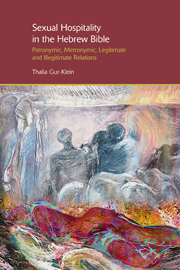 Sexual Hospitality in the Hebrew Bible
Sexual Hospitality in the Hebrew Bible Book contents
- Frontmatter
- Contents
- Acknowledgements
- Introduction
- 1 Patriarch hospitality and sexual hospitality
- 2 Marital and non-marital systems
- 3 Baal marriage of dominion
- 4 Metronymic marriage: remaining with kin – counter-patterns of baal marriage
- 5 Intersecting patterns and conflicting imperatives
- 6 Widow marriage, land and kin surrogacy
- Epilogue: moral imagination
- Notes
- Bibliography
- Index
3 - Baal marriage of dominion
- Frontmatter
- Contents
- Acknowledgements
- Introduction
- 1 Patriarch hospitality and sexual hospitality
- 2 Marital and non-marital systems
- 3 Baal marriage of dominion
- 4 Metronymic marriage: remaining with kin – counter-patterns of baal marriage
- 5 Intersecting patterns and conflicting imperatives
- 6 Widow marriage, land and kin surrogacy
- Epilogue: moral imagination
- Notes
- Bibliography
- Index
Summary
Multiplicity of conjugal patterns, I
Sexuality wavers between the physiological, socio-cultural and economic strata; the social realm represents bars and prohibitions on sexual relations, while the physical world implies drives to satisfy sexuality. While the physical realm resides in the personal domain, culture materializes in the social realm of laws and customs while inhering in interrelations with others (Lévi-Strauss 1969: 12; Frymer-Kensky 1999: 293).
Expanding on these propositions, the socio-cultural and economic strata precipitate imposition of various systems on sexual relations. Accordingly, Robertson Smith proposes that different social classes and economic levels abide by differentiating types of conjugal bonds, connubial rules and marital status in Ancient Arabia (Robertson Smith [1885] 1907: 271–2). This postulation will be expounded to fit biblical texts in the following.
Biblical texts suggest that the rich and the royal can afford a polygamous house-hold, which generates its own rules, contracts, conjugal relations and marital statuses. Solomon's harem consists of one husband and one thousand women acquired from far and wide, presumably by political ties or purchase. The women are ranked according to a sliding scale, with high-status wives being accorded first-wife status, while women of lower socio-economic families are called concubines, denoting secondary status. Slave-wives or female slaves are not counted (1 Kgs 11:1–3). Conversely, a small farm holder like Elimelech has one wife who solely holds the position of his chief-wife and materfamilias (Ruth 1:1–2). An impoverished man may not be able to acquire and maintain a wife.
- Type
- Chapter
- Information
- Sexual Hospitality in the Hebrew BiblePatronymic, Metronymic, Legitimate and Illegitimate Relations, pp. 85 - 158Publisher: Acumen PublishingPrint publication year: 2013


